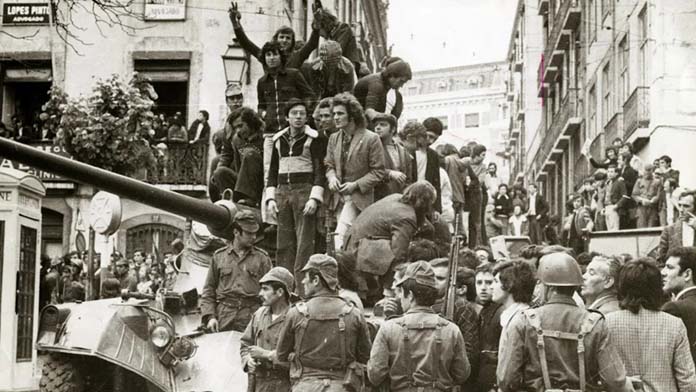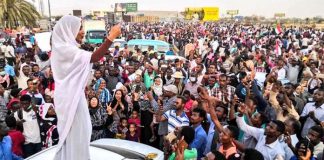The revolution in Portugal, beginning 50 years ago in 1974 with a revolt in the army, saw workers take control of hundreds of factories, writes Luke Ottavi
Portugal was swept by revolution after junior army officers led a military coup against fascist dictator Marcelo Caetano on 25 April 1974.
The coup came as a result of protracted and costly wars against national liberation movements in the Portuguese colonies of Guinea, Mozambique and Angola.
The colonial wars were sapping government expenditure and more than 13,000 Portuguese soldiers had died—more than the country had lost in any conflict since the Napoleonic wars.
The junior army officers felt humiliated by their inability to suppress African armed resistance and were becoming increasingly hostile to a regime that wanted to see total victory in Africa.
The wars in Africa led to a revolution at home.
Portugal had been living under fascism since 1932, first under Antonio Salazar and then Caetano.
Workers had no right to strike nor a right to form unions, political parties were banned and there was extreme press censorship. Criticism of the regime resulted in imprisonment and torture by the notorious secret police.
Wages were low and a large peasantry lived in the north of country, some in serf-like conditions.
Portugal desperately needed to modernise its economy and foreign companies were eager to take advantage of low wages and a well-controlled workforce.
Since 1961, Portugal’s colonial wars had resulted in the mobilisation of 200,000 soldiers in a country of eight million people. At their height, this consumed 8 per cent of GDP and 40 per cent of government expenditure.
Portugal wanted to cling onto its withering empire as it was a source of cheap raw materials and secure markets for Portugal’s industrial goods.
With the onset of the colonial wars, recruitment to the officer academies fell as the wealthy young men who had traditionally led the army sought to avoid dying in war.
The men now coming through the officer corps were from a lower social and class background than previously. Many were from the provinces or overseas colonies.
It was from this strata that the Armed Forces Movement, the MFA, would draw its support.
During the course of the African wars, a phrase went round the new Portuguese officers, “If I was a black man, I too would be a terrorist.” One young captain who went on to play a prominent role in the MFA, Diniz Almeda, went so far as to say that “we had no reason to fight”.
The Armed Forces Movement
Initially, 136 officers held a secret meeting in the Portuguese countryside.
Due to the need for secrecy, the officers ostensibly met for a “special farmhouse barbeque”. This was the inaugural meeting of the MFA. By April 1974 it had a network of 300 supporting officers.
The MFA were not radicals. They wanted a “democratic, modern, mixed economy” akin to other Western European states. This dovetailed with the needs of prominent Portuguese capitalists who recognised the need to modernise the economy.
The MFA led its successful coup on 25 April 1974.
Officer Otelo de Carvalho, who helped plan it, stated that the main purpose was to “reconquer the prestige of the Army and the Armed Forces”.
The MFA never intended to govern Portugal, even temporarily. Instead, they called upon a group of eminent soldiers, led by General Spinola—himself a close associate of Caetano—to govern. This military junta set up the first provisional government.
Unexpected strikes
Public reaction to the coup was initially cautious but slowly crowds gathered in Lisbon where the coup took place.
The slogan “the MFA is with the people, the people are with the MFA” was soon chanted enthusiastically by the crowds. Joyriders rode on tanks around the city and red carnations were stuffed into the barrels of the soldiers’ guns and became a symbol for the revolution.
There was only one factory on strike on the day of the coup but when workers get word of it they soon started celebrating at work.
Management wanted to continue production but workers wanted to bring the revolution into the workplace. Not only were demands for higher wages made, but also the purging of fascist managers and secret police informants—known as “saneamento”.
These demands were taken up in workplaces across the country.
Between 25 April and May Day—which was declared a public holiday for the first time—there was a festival of the oppressed.
Some 200,000 workers went on strike across key industries including shipbuilding, textiles, electronics, hotels and catering and banking.
Workers’ commissions were formed in individual factories that held mass meetings to push forward their demands.
Many managers fled or were kicked out by the workforce and hundreds of workplaces were put under workers’ control.
The strikes, occupations and land seizures terrified the ruling class.
One participant in the revolution, Clara Queiroz, recounts how, “Under fascism everyone had been afraid of their neighbours, of being informed on. But now came the explosion and people came to the streets. The informers had vanished.”
On 29 April 100 families living in shanty towns occupied a new government housing project on the outskirts of Lisbon. Soon, more than 2000 houses were occupied around the country.
Students in high schools and universities held frequent general assemblies. In one high school, students made a list of teachers and pupils who were thought to collaborate with the secret police.
Participant Bruno Ponte tells how, “There were meetings in all the universities that kicked out lecturers associated with the old regime and invited back all the expelled students.”
Two high-profile examples of workers’ control were in the media. Republica newspaper, owned by a member of the moderate Socialist Party, was being forced to become a mouthpiece for the party.
Workers went on strike against job cuts and to demand an independent political position for the paper. They elected a workers’ committee to run it. The owner called in the army—but they refused to help him sack the workforce and handed control back to the workers’ committee.
Radio Renascenca was run by the Catholic Church, which had supported fascism.
The workers took it over and programming was done by a general assembly. Reports of workers’ struggles were regularly broadcast and a microphone was hung in the street to broadcast from demonstrations passing by.
Eventually the government resorted to terrorism by literally blowing it up.
Popular power
But simply occupying the land and factories did not mean that workers now ran the country. The crucial question of who wielded political and social power—the working class, the MFA or the ruling class—was not yet settled.
For a year and a half there were continuous demonstrations, spreading workers’ control in the factories. Several attempted right-wing coups tried to rein this in but were stopped through massive workers’ mobilisations.
But the popularity of the MFA led most workers into thinking that the army would act in their interests.
Revolutionary socialist Chris Harman describes how the workers were disarmed, “Because they looked to the armed forces to act for them, and inside the armed forces the rank-and-file looked to the progressive officers for a lead.”
The junior officers that led the 25 April coup had privileges inside the army that working class revolt—and especially organisation among the rank-and-file soldiers—would take away.
Officers were paid 12 or 20 times more than rank-and-file soldiers.
The MFA had no interest in smashing the conventional army structure as they had a privileged position within it. But this left the army under the control of senior officers who wanted to stamp out radicalism in the army and bring workers’ control in the factories to an end.
The scale of workers’ struggles and the widespread workers’ control in the factories meant there was a possibility of fighting for a socialist revolution to put the whole of society under the democratic control of the working class.
For this happen the workers’ committees and inter-factory commissions needed to unite into suburb and city-wide workers’ councils. This would lay the basis for an alternative workers’ government that could challenge for state power. But there was no party within the working class organising for this to happen.
The largest force on the left was the Communist Party (PCP). It had been operating illegally for decades and many respected it for its role in fighting against fascism.
At the time of the coup the PCP had about 5000 members and some influence in the working class.
However, its Stalinist politics meant the PCP doggedly held to a stages theory of revolution. According to them, Portugal was too “backwards” to allow for a successful socialist revolution and so the first task was to build the country’s industrial base.
The PCP exhorted workers to “save the national economy” and to not strike. Indeed, the PCP was involved in many strike-breaking efforts.
By November 1975 indiscipline among the troops was widespread, and working class struggle was still growing. The army command moved to break the MFA and its influence in the army.
Radical soldiers and officers were purged from the army by “moderate” generals and officers in the MFA.
The hold that left-leaning MFA officers had over the army and government was broken.
In the election held on July 1976 the reformist Socialist Party—abject collaborators with the right-wing of the army—swept to victory and its leader Mario Soares became prime minister. The Socialist Party was able to restore capitalist normality and wind down the struggle of the working class.
There was no going back to Caetano’s fascist regime. The colonies gained their independence and the ruling class put its hopes in a parliamentary democracy to develop the economy and further integrate Portugal into Europe.
But Portugal provides an important example of how war can lead to revolution and the power the working class has to threaten the rule of capital.






